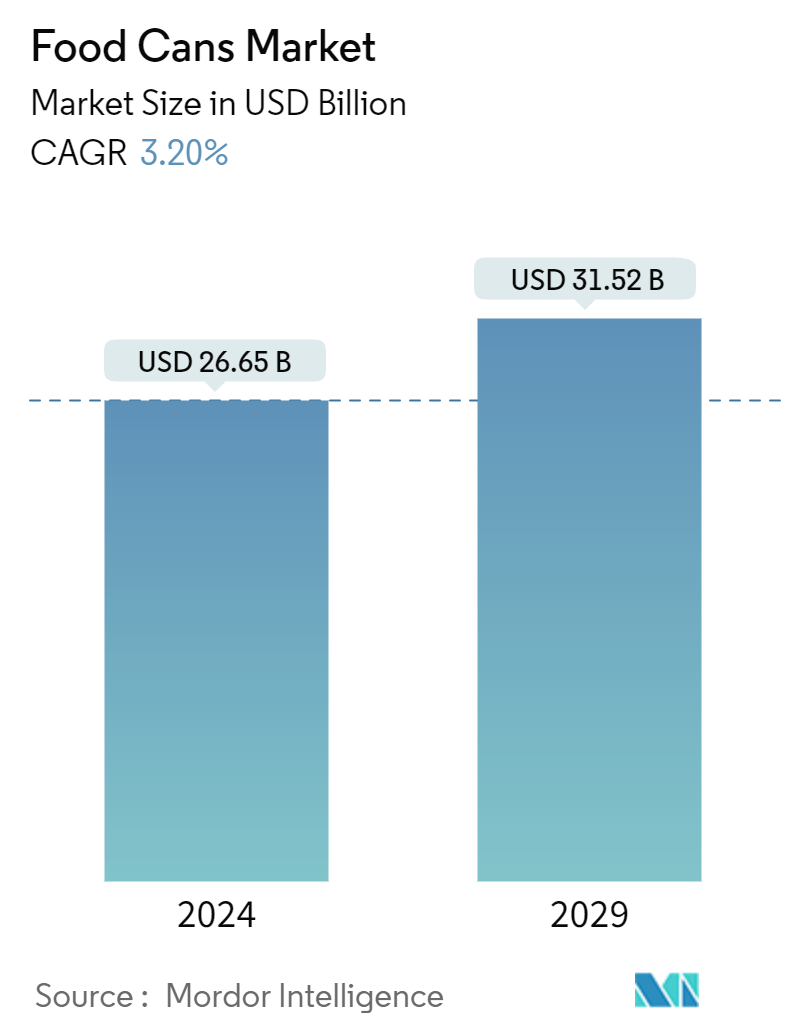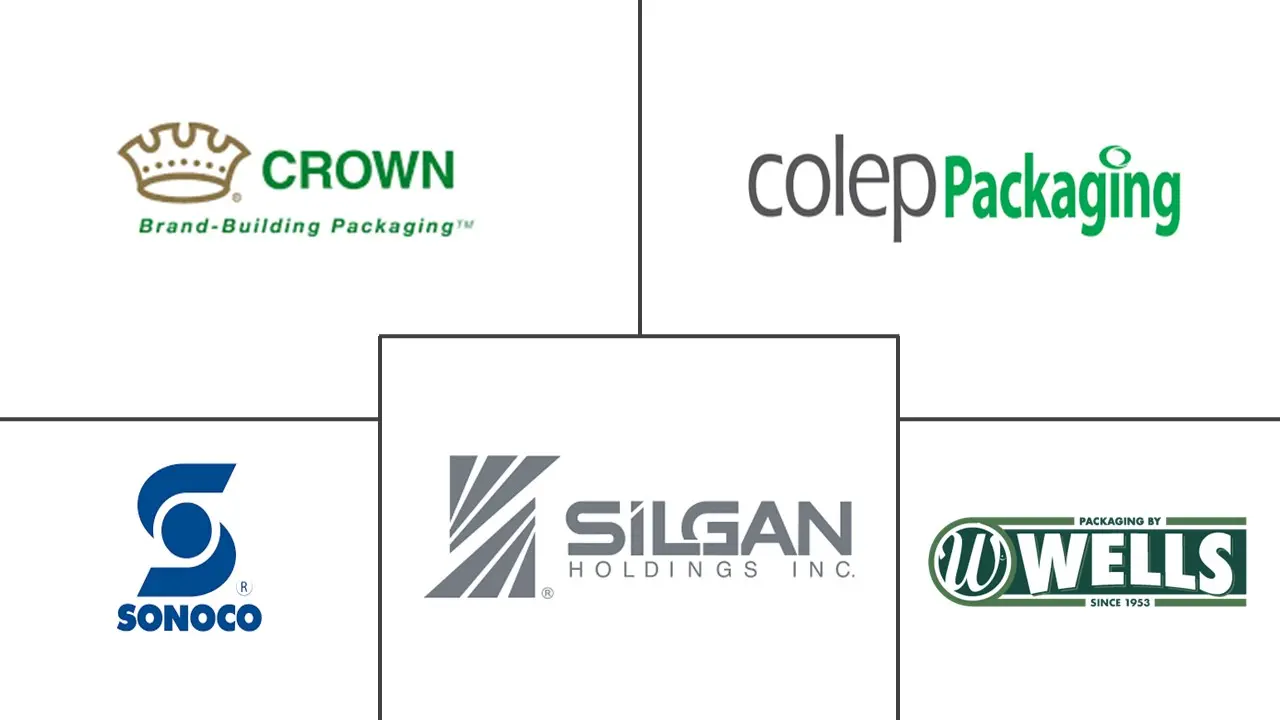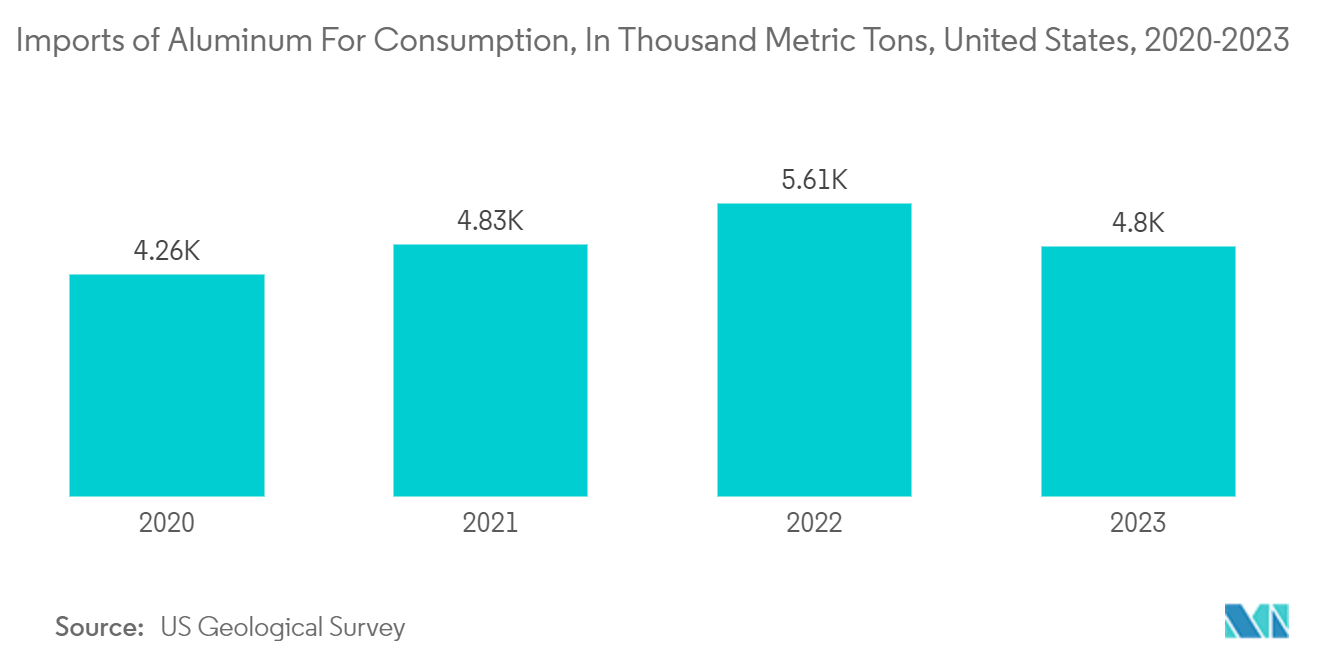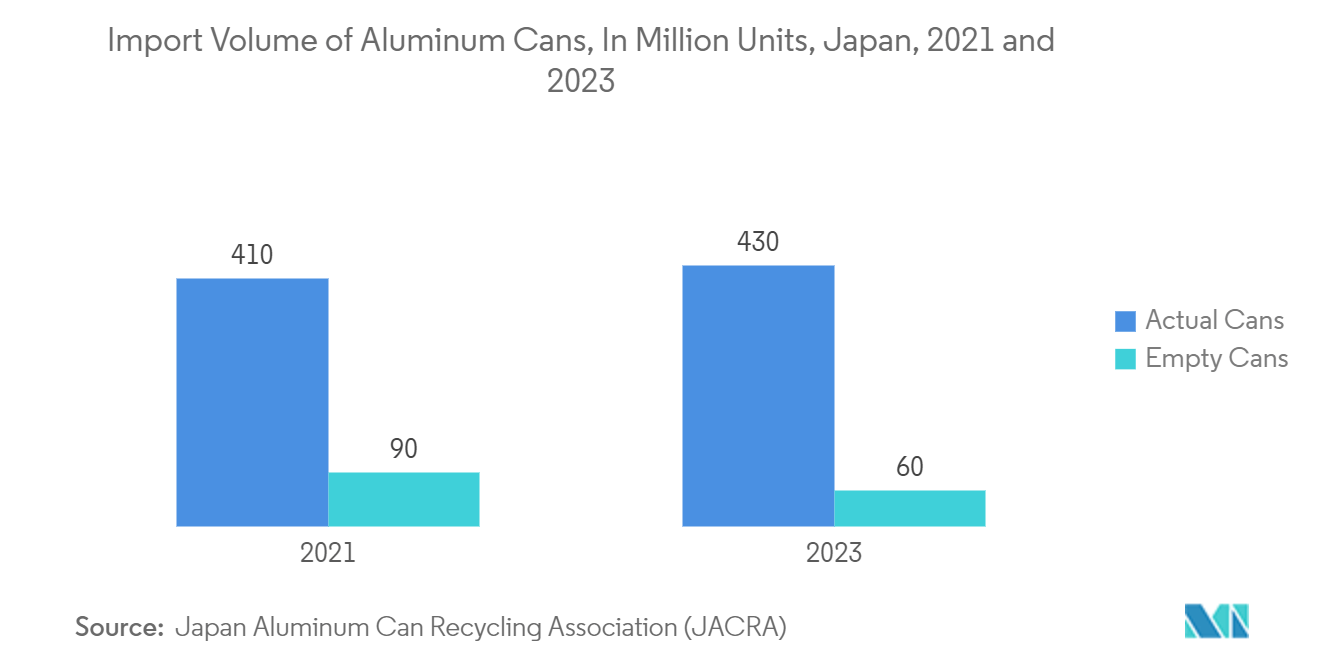Food Cans Market Size

| Study Period | 2019 - 2029 |
| Market Size (2024) | USD 26.65 Billion |
| Market Size (2029) | USD 31.52 Billion |
| CAGR (2024 - 2029) | 3.20 % |
| Fastest Growing Market | Asia Pacific |
| Largest Market | North America |
Major Players
*Disclaimer: Major Players sorted in no particular order |
Need a report that reflects how COVID-19 has impacted this market and its growth?
Food Cans Market Analysis
The Food Cans Market size is estimated at USD 26.65 billion in 2024, and is expected to reach USD 31.52 billion by 2029, growing at a CAGR of 3.20% during the forecast period (2024-2029).
The increase in the popularity of canned food to preserve a wide variety of food, such as fruits, vegetables, beans, soups, meats, and seafood, offers significant market opportunities for packaging companies. The surge in demand for ready-to-eat canned food products in developing countries is expected to boost the market value.
- Food cans are a widespread option for maintaining the freshness and nutritional content of food products. An increase in the canning process to enhance the shelf life of packaged food is expected to strengthen the food cans market. The rise in the utilization of steel as the material for cans for packaging beverages and frozen dairy products presents significant opportunities for companies operating in the market.
- On the other hand, metal cans are infinitely recyclable, which is anticipated to fuel the growth of these cans among food packaging companies. According to the American and Iron Steel Institute, over 90% of the co-products from the steel-making process are reused or recycled.
- Rapid urbanization, changing food habits, increased income levels, and increased consumption of ready-to-eat food are fueling the demand for canned food cans across the world. Moreover, the rise in concern over food quality and increased demand for hygienic food are expected to contribute to the market growth. Significant demand for food packaging solutions in developing countries offers lucrative opportunities for market players.
- The industry also needs help with alternative packaging options, such as plastic packaging. Plastic is a widely used packaging material in the food industry. It is known for its flexibility, durability, and lightweight. The usage of recyclable plastic materials is gaining traction due to the growing concerns about environmental pollution caused by plastic. Such growth of alternative materials can affect the market growth of food cans.
- Metal can packaging faces much competition from other packaging solutions such as plastic, paper, or glass. Plastic packaging continues to be the main competitor of metal packaging. The food industry, the primary user of metal cans, has started adopting recyclable plastic packaging solutions. Plastic cans are transparent, which helps brands to show their food's quality. Plastic's transparent and cost-effective properties might limit the metal food cans market.
Food Cans Market Trends
Aluminum Cans to Witness Highest Market Growth
- Aluminum cans deliver long-term food quality preservation advantages. These cans offer nearly 100% protection against light, oxygen, moisture, and other contaminants. They are rust and corrosion-resistant, providing extended shelf life. Aluminum has significant properties, such as being smoother and lighter, aiding manufacturers in saving logistics expenses.
- Aluminum cans are gaining significance due to various factors, such as stackability, light weight, strength, resistance to transportation, irregular handling, and easy recyclability, allowing brands to package and transport more using less material. According to the US Geological Survey, the imports of aluminum consumption in 2021 were 4,830 thousand metric tons, and they reached 4,800 thousand metric tons in 2023.
- One of the significant benefits of aluminum cans is that they are recyclable. Almost 100% of the aluminum used in the cans can be melted down and utilized too. These can be recycled at the end of their lifecycle, making them the preferred packaging type for brands across the food industry.
- According to a new study by the NYU School of Global Public Health researchers, the consumption of ultra-processed foods has risen over a couple of decades across nearly all segments of the US population. The composition of the average US diet has moved toward a more processed diet. This is concerning, as eating more ultra-processed foods is associated with inadequate diet quality and a higher risk of several chronic diseases. Ultra-processed foods are industrially manufactured, ready to eat or heat, include additives, and are mainly devoid of whole foods.
- The recyclability of product packaging is of increasing interest to consumers seeking more sustainable products. As a result, aluminum, which is touted as infinitely recyclable, is gaining traction among product manufacturers and the consumers they serve. Industries transitioning to aluminum include food packaging products. The move to aluminum is reflected in the expected growth of green packaging.

Asia-Pacific Expected to Register Fastest Growth
- The environmental advantages of metal cans and their easy and quick recycling, along with the growing demand for canned products, are anticipated to positively affect the market growth in the region. Increasing government restrictions on plastic packaging products for packing vegetables, noodles, meat, etc., are creating opportunities for market growth.
- Growing demand for the utilization of natural resources in the region has revved recycling activities and increased the reuse of metals in the Asia-Pacific. There are substantial variations in the recycling rate of aluminum cans across the countries in the region.
- Countries such as Japan import aluminum cans to the country, and according to the Japan Aluminum Cans Recycling Association (JACRA), in 2023, the actual cans imported were 430 million units, and empty cans were 60 million units, and imports increased from 410 actual cans and 90 empty cans in 2021.
- Increased urbanization, higher disposable incomes, the growth of nuclear families, and a preference for convenience goods are driving the demand for processed food products. Selling food in processed form allows one to charge a more significant price and capture a more considerable economic value. For instance, according to an estimation by the RBI, manufacturing prepared meals adds 30% value to the product, whereas processing meat adds 12.7%.
- According to the IBEF, India has significant potential to become a global processed food export powerhouse. It includes an affluent agricultural resource base, strategic geographic location and proximity to food-importing countries, and an expansive network of food processing training, academic, and research facilities. With a market size of USD 866 billion in 2022, the food industry was projected to be critical to the economy's growth. In 2023, the food market was expected to generate USD 963 billion in revenue.

Food Cans Industry Overview
The food cans market is fragmented in nature, as many key players continually try to gain maximum market share. Some of the major players include Crown Holdings Inc., Silgan Holdings Inc., CANPACK SA, Wells Can Company, and Sonoco Products Company.
- In January 2024, Australian packaging and recycling company Visy Industries, a provider of food cans, announced the acquisition of Advanced Circular Polymers (ACP), a plastic recycling company. This strategic move will bolster Visy’s recycling operations and prevent a significant volume of hard-to-recycle plastics from ending in landfills.
- In November 2023, Sonoco Products Company purchased the composite can operations of Amcor Packaging (Australia). The Amcor operations consist of two plants, one in suburban Melbourne and the other in Sydney, and they mainly serve the spice, food, and cleanser sectors. Acquiring the Amcor can plants will further strengthen its position in the Asia-Pacific.
Food Cans Market Leaders
Crown Holdings, Inc.
Silgan Holdings, Inc.
Colep Packaging
Sonoco Products Company
Wells Can Company
*Disclaimer: Major Players sorted in no particular order
.webp)
Food Cans Market News
- October 2023: Colep Packaging and the Envases Group signed a joint venture agreement to construct an aerosol packaging plant in Mexico. Based on a 50/50 shareholding, the deal will represent a total initial investment of more than USD 30 million over two years. The new plant will focus on three aluminum aerosol lines in the first stage. This production unit aims to serve customers in Mexico and the entire Central American market.
- July 2023: Jamestrong and the University of New South Wales (UNSW) collaborated to advance aluminum manufacturing and recycling in Australia. Jamestrong and UNSW will fund the joint project as part of the government’s Trailblazer for Recycling and Clean Energy (TRaCE) program. The new ‘Green Aluminium partnership’ will include commercializing the UNSW’s SMaRT Technology Centre’s advanced MICROfactorie recycling technology. This technology will be incorporated into Jamestrong’s can manufacturing process at its facility in Taree, New South Wales.
Food Cans Market Report - Table of Contents
1. INTRODUCTION
1.1 Study Assumptions and Market Definition
1.2 Scope of the Study
2. RESEARCH METHODOLOGY
3. EXECUTIVE SUMMARY
4. MARKET INSIGHTS
4.1 Market Overview
4.2 Industry Value Chain Analysis
4.3 Industry Attractiveness - Porter's Five Forces Analysis
4.3.1 Bargaining Power of Suppliers
4.3.2 Bargaining Power of Buyers
4.3.3 Threat of New Entrants
4.3.4 Threat of Substitute Products
4.3.5 Intensity of Competitive Rivalry
5. MARKET DYNAMICS
5.1 Market Drivers
5.1.1 Improving Income Levels and Development of Retail Systems are Increasing the Consumption of Packaged Food and Beverages.
5.2 Market Restraints
5.2.1 Increasing Demand for Alternatives, such as Flexible Plastics, in the Food Industry.
6. MARKET SEGMENTATION
6.1 By Material Type
6.1.1 Aluminium Cans
6.1.2 Steel Cans
6.2 By Application
6.2.1 Ready Meals
6.2.2 Powder Products
6.2.3 Fish and Seafood
6.2.4 Fruits and Vegetables
6.2.5 Processed Food
6.2.6 Pet Food
6.2.7 Other Applications
6.3 By Geography***
6.3.1 North America
6.3.1.1 United States
6.3.1.2 Canada
6.3.2 Europe
6.3.2.1 United Kingdom
6.3.2.2 Germany
6.3.2.3 France
6.3.2.4 Spain
6.3.2.5 Italy
6.3.3 Asia
6.3.3.1 China
6.3.3.2 India
6.3.3.3 Japan
6.3.3.4 Australia and New Zealand
6.3.4 Latin America
6.3.4.1 Brazil
6.3.4.2 Mexico
6.3.4.3 Argentina
6.3.5 Middle East and Africa
6.3.5.1 United Arab Emirates
6.3.5.2 Saudi Arabia
6.3.5.3 South Africa
7. COMPETITIVE LANDSCAPE
7.1 Company Profiles
7.1.1 Crown Holdings, Inc.
7.1.2 Wells Can Company
7.1.3 Kian Joo Group
7.1.4 Silgan Holdings Inc.
7.1.5 CANPACK S.A. (CANPACK Group)
7.1.6 Aaron Packaging Inc.
7.1.7 Toyo Seikan Group Holdings Ltd.
7.1.8 Visy Industries
7.1.9 Jamestrong Packaging
7.1.10 Colep Packaging
7.1.11 Trivium Packaging
7.1.12 Sonoco Products Company
- *List Not Exhaustive
8. INVESTMENT ANALYSIS
9. FUTURE OF THE MARKET
Food Cans Industry Segmentation
Food cans are among one of the packaging options for the mobile lifestyle. These can be carried easily to outdoor sporting events, festivals, and more, whereas glass is typically forbidden because of its breakability. The affordability and recyclability of cans, the rising popularity of canned food, and the launch of new food products are expected to contribute to the market growth in the future.
The food cans market is segmented by material (aluminum cans and steel/tin cans), application (ready meals, powder products, fish and seafood, fruits and vegetables, processed food, pet food, and other applications), and geography (North America (United States and Canada), Europe (United Kingdom, Germany, France, Italy, and Rest of Europe), Asia-Pacific (China, Japan, India, Australia and New Zealand, and Rest of Asia-Pacific), Latin America (Brazil, Mexico, and Rest of Latin America), and Middle East and Africa (United Arab Emirates, South Africa, Saudi Arabia, and Rest of Middle East and Africa). The market sizes and forecasts are provided in terms of value (USD) for all the above segments.
| By Material Type | |
| Aluminium Cans | |
| Steel Cans |
| By Application | |
| Ready Meals | |
| Powder Products | |
| Fish and Seafood | |
| Fruits and Vegetables | |
| Processed Food | |
| Pet Food | |
| Other Applications |
| By Geography*** | |||||||
| |||||||
| |||||||
| |||||||
| |||||||
|
Food Cans Market Research FAQs
How big is the Food Cans Market?
The Food Cans Market size is expected to reach USD 26.65 billion in 2024 and grow at a CAGR of 3.20% to reach USD 31.52 billion by 2029.
What is the current Food Cans Market size?
In 2024, the Food Cans Market size is expected to reach USD 26.65 billion.
Who are the key players in Food Cans Market?
Crown Holdings, Inc., Silgan Holdings, Inc., Colep Packaging, Sonoco Products Company and Wells Can Company are the major companies operating in the Food Cans Market.
Which is the fastest growing region in Food Cans Market?
Asia Pacific is estimated to grow at the highest CAGR over the forecast period (2024-2029).
Which region has the biggest share in Food Cans Market?
In 2024, the North America accounts for the largest market share in Food Cans Market.
What years does this Food Cans Market cover, and what was the market size in 2023?
In 2023, the Food Cans Market size was estimated at USD 25.80 billion. The report covers the Food Cans Market historical market size for years: 2019, 2020, 2021, 2022 and 2023. The report also forecasts the Food Cans Market size for years: 2024, 2025, 2026, 2027, 2028 and 2029.
Food Cans Industry Report
Statistics for the 2024 Food Cans market share, size and revenue growth rate, created by Mordor Intelligence™ Industry Reports. Food Cans analysis includes a market forecast outlook to 2029 and historical overview. Get a sample of this industry analysis as a free report PDF download.
